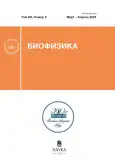ВЛИЯНИЕ ВИРУСНОГО ЛИЗИСА НА ПОГЛОЩЕНИЕ СВЕТА КУЛЬТУРОЙ ЧЕРНОМОРСКОЙ МИКРОВОДОРОСЛИ Tetraselmis viridis
- Авторы: Шоларь С.А1, Степанова О.А2
-
Учреждения:
- ФИЦ «Морской гидрофизический институт РАН»
- Институт природно-технических систем РАН
- Выпуск: Том 69, № 2 (2024)
- Страницы: 311-316
- Раздел: Статьи
- URL: https://journals.rcsi.science/0006-3029/article/view/257580
- DOI: https://doi.org/10.31857/S0006302924020125
- EDN: https://elibrary.ru/OTYFVU
- ID: 257580
Цитировать
Полный текст
Аннотация
Ключевые слова
Об авторах
С. А Шоларь
ФИЦ «Морской гидрофизический институт РАН»
Email: sa.sholar@mail.ru
Севастополь, Россия
О. А Степанова
Институт природно-технических систем РАН
Email: solar-ua@ya.ru
Севастополь, Россия
Список литературы
- Fuhrman J. A. and Suttle C. A. Viruses in marine planktonic systems. Oceanography, 6 (2), 51–63 (1993). doi: 10.5670/oceanog.1993.14
- Suttle C. A. Marine viruses—major players in the global ecosystem. Nature Rev. Microbiol., 5 (10), 801–812. (2007). doi: 10.1038/nrmicro1750
- Mendzhul M. I., Lysenko T. G., and Syrchin S. A. Development of cyanobacterial phages at the Institute of Microbiology and Virology of the National Academy of Sciences of Ukraine (History and perspectives). Mikrobiol. Zhurn., 65 (1), 133–140 (2003). EDN: OHZKQG
- Sholar S. A. and Stepanova O. A. The Role of Viruses and Viral Lysis in Changing the Optical Properties of the Water Environment of their Habitat. Biophysics, 66 (2), 182–191 (2021). DOI: 10.1134/ S0006350921020226
- Ли М. Е. Г. и Шоларь С. А. Мобильная установка для определения в режиме удаленного доступа влияния штаммов черноморских альговирусов и вирусного лизиса представителей фитопланктона на оптикофизические свойства морской воды. Патент РФ на изобретение № 2759907 C1, Бюл. № 32 (2021). EDN: RSLILU
- Vincent F., Gralka M., Schleyer G., Schatz D., Cabrera-Brufau M., Kuhlisch C., Sichert A., VidalMelgosa S., Mayers K., Barak-Gavish N., Flores J. M., Masdeu-Navarro M., Egge J. K., Larsen A., Hehemann J.-H., Marrasé C., Simó R., Cordero O. X., and Vardi A. Viral infection switches the balance between bacterial and eukaryotic recyclers of organic matter during coccolithophore blooms. Nature Commun., 14 (1), 510 (2023). doi: 10.1038/s41467-023-36049-3
- Токарев Ю. Н., Финенко 3. 3. и Шадрин Н. В. Микроводоросли Черного моря: проблемы сохранения биоразнообразия и биотехнологического использования (ИнБЮМ, Севастополь, 2008). EDN: YWHYTB
- Горбунова С. Ю. и Тренкеншу Р. П. Опыт получения альгологически чистой культуры Tetraselmis viridis Rouch. в нестерильных условиях. Вопр. соврем. альгологии, 1 (22), 94–100 (2020). doi: 10.33624/2311-0147-2020-1(22)-94-100, EDN: YMNLAP
- Das P., Thaher M. I., Hakim M. A. Q. M. A., AlJabri H. M. S. J., and Alghasal G. S. H. S. . A comparative study of the growth of Tetraselmis sp. in large scale fixed depth and decreasing depth raceway ponds. Bioresource Technol., 216, 114–120 (2016). doi: 10.1016/j.biortech.2016.05.058
- Pulz O. and Gross W. Valuable products from biotechnology of microalgae. Appl. Microbiol. Biotechnol., 65 (6), 635–648 (2004). doi: 10.1007/s00253-004-1647-x
- Griffiths M. J., van Hille R. P., and Harrison S. T. L. Lipid productivity, settling potential and fatty acid profile of 11 microalgal species grown under nitrogen replete and limited conditions. J. Appl. Phycol., 24, 989– 1001 (2012). doi: 10.1007/s10811-011-9723-y
- Kleivdal H., Chauton M. S., and Reitan K. I. Industrial production of marine microalgae as a source of EPA and DHA rich raw material in fish feed–Basis, knowledge status and possibilities (SINTEF, Bergen, 2013).
- Bucher H. C., Hengstler P., Schindler C., and Meier G. N-3 polyunsaturated fatty acids in coronary heart disease: a meta-analysis of randomized controlled trials. Am. J. Med., 112 (4), 298–304 (2002). doi: 10.1016/S0002-9343(01)01114-7
- Whelan J. Dietary stearidonic acid is a long chain (n-3) polyunsaturated fatty acid with potential health benefits. J. Nutrition, 139 (1), 5-10 (). DOI: 10.3945/ jn.108.094268
- Ulmann L., Blanckaert V., Mimouni V., Andersson M., Schoefs B., and Chénais B. Microalgal fatty acids and their implication in health and disease. Mini Rev. Med. Chem., 17 (12), 1112–1123 (2017). doi: 10.2174/1389557516666160722132736
- Stepanova O. A. Black Sea algal viruses. Russ. J. Mar. Biol., 42 (2), 123–127 (2016). DOI: 10.1134/ S1063074016020103
- Stepanova O. A., Boĭko A. L., and Shcherbatenko I. S. Computational genome analysis of three marine algoviruses. Mikrobiol. Zhurn., 75 (5), 76-81 (2013).
- https://solinstruments.by/produkciya/spektrofotometry/mc-122/dopolnitelnoe-oborudovanie/
- Тренкеншу Р. П. и Лелеков А. С., Моделирование роста микроводорослей в культуре (ООО «Константа», Белгород, 2017). EDN: XTJPCH
- Новикова Т. М. Влияние средней поверхностной освещенности на ростовые характеристики Tetraselmis viridis. Вопр. соврем. альгологии, № 1 (13) (2017). EDN ZCDLNP.
- Чернышев Д. Н., Горбунова С. Ю. и Тренкеншу Р. П. Разделение спектров поглощения культуры и ацетонового экстракта микроводоросли Tetraselmis viridis на спектры отдельных пигментов. Актуал. вопр. биол. физики и химии, 5 (2), 232–238 (2020). EDN: UVYKFN
- Simis S. G. H., Tijdens M., Hoogveld H. L., and Gons H. J. Optical changes associated with cyanobacterial bloom termination by viral lysis. J. Plankton Res., 27 (9), 937–949 (2005). doi: 10.1093/plankt/fbi068, EDN: IYRQHR
Дополнительные файлы










